Sun 25 Mar 2012
The striped shawl sweater has been slowly creeping slowly forward with the same knit-rip-knit pace. I’m past the striped section and have been working short rows to transition into the main body color. I started out decreasing one stitch for every three rows that I knit, which looked pretty good at first, but looked less good as the fabric grew. I worked short rows for both of the sleeves and half of the body before deciding that it looked a little too puffy.
See how there’s a bump at the edge of the dark fabric? Well. It was bothering me. So I ripped it out, and reknit the short rows, decreasing one stitch for every 2 rows instead.
Isn’t that better?
I’ve since redone the short rows, and finished the main body section. I had to spin some more yarn to make it, but I am very happy with how it’s coming out.
I am to the elbows on the sleeves and I am running on yarn fumes, so I’ll need to spin up another hundred yards or so to finish it off. I hadn’t counted on the short row decreases to add so much shaping, and I added a few of my own, which turns out to have been unnecessary. The final fit ended up a tiny bit tighter than I’d like, but I think it will loosen up with blocking and I don’t think it’s enough of a problem to rip back again. This project may finally be in the home stretch. All that’s left is finishing the sleeves, and then steeking the front to install the zipper. It’s getting close!
While I’ve been knitting the striped shawl, I’ve been keeping my spinning wheel busy finishing up the green for the fall colors sweater.
It’s all finished now, and will be ready to go as soon as I settle on a design. I’d like to say that it will be simple to make up for the last, but somehow I think that’s unlikely. (I’m still leaning toward the last design in this post, which will involve both steeking and a little bit of tailoring, and I’m thinking it likely that it will also have some rather experimental colorwork going on. Never a dull moment around here.)
Amazingly, that brought me to the end of what had seemed like a very long spinning queue, and suddenly it was time to start spinning the wool for Mike’s sweater, months earlier than I had planned. He’s a close friend of ours, and I think this may officially be the first big thing I’ve knit for someone outside of the family (mostly I knit just for Branden and I). We usually stay at Mike’s house over Christmas, and he was especially taken with Branden’s MacGyver sweater this year. He kept asking how long it took to make a sweater, from spinning the wool through to wearing it. I didn’t know, but I’ve decided to find out by spinning up the rest of the Shetland that I bought from that farm. Since Mike is also of an engineering bent and loved the MacGyver angle, I’ll also work in some of the leftover MacGyver yarn, probably as colorwork or stripes around the shoulders. For now, I’m spinning some wool from Harriet:
Doesn’t she have a lovely fleece? I liked it well enough in the roving, but it wasn’t until I started spinning it that I realized how beautifully heathered the gray is going to be. I have to admit that I have been struggling to resist the temptation to claim this wool as mine (as it was originally intended to be), but I am going to stick to the current plan. There will always be more fleeces, and I am getting to have a lot of sweaters!
One thing that has been very interesting about this set of projects is spinning from three fleeces from the same farm. You’d think they’d be pretty similar, given that they are three sheep fed and coated the same way, living in the same flock. The wool was presumably sheared by the same shearer and processed by the same mill. But the fleeces are not the same. As a reminder, MacGyver’s is the light gray wool in the sweater, and Magnolia’s is the dark brown.
MacGyver’s wool was kind of downy, but had lots of heavier guard hairs in it. I tried picking them out as I went, but enough stayed in to make the sweater slightly prickly when worn on sensitive skin (fortunately, Branden doesn’t mind). As Branden has worn the sweater, the guard hairs have tended to poke out here and there, and we’ve been pulling them out over time. I’m not sure that it’s making much difference, but I like to think that the sweater is getting softer and softer with time. Either that, or we’re helping it to fall apart faster, but I’m sticking to the first interpretation. MacGyver’s was the first wool of the three that I spun, and it was full of little pills of short fiber, like the wool had been slightly tipped or there were second cuts in the shearing. I must admit that I was not looking forward to spinning three big bags of wool like that; pills in the spinning make me crazy. But the fiber was beautiful otherwise, and I loved the yarn, so I kept spinning.
Magnolia’s wool had none of the pills, and none of the guard hairs. It was a much thicker feeling fiber, very smooth and greasy, almost like alpaca. The pills must have been from MacGyver and not from the mill, since both Magnolia and Harriet’s fleeces are pill-free. Harriet’s fiber is different yet again. It is much lighter than Magnolia’s and very soft, Â more like the downy fleece in MacGyver’s wool. There aren’t many guard fibers at all, though there is a lot of hay. Harriet loved to wear her hay. I pull little bits out as I’m spinning, and I can’t help but imagine this sheep standing by her hay bale, munching away, pulling it down on top of her shoulders. Fortunately, most of it pops right out while I’m spinning, so it’s not a big deal, but it does amuse me to think of how this sheep must have always been wearing her food.
While I knit one sweater and spin toward the next, I’ve also been taking advantage of the beautiful weather to get outside and comb some more of my Gulf Coast fleece from last year. It is slow going, preparing a whole fleece by hand. I spun up most of what I had combed at Christmas to give to a friend, and I’ve only done a few ounces since then. It will be quite a while before I work my way through the whole 2.5 lbs, but it is very satisfying to see my bag fill up with these airy little puffs of fiber.
So there we have it. Handspun wool in all its stages. (Now all I need is a sheep.)
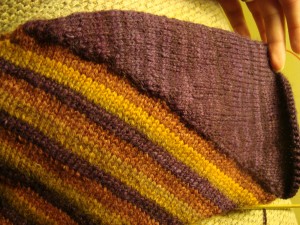
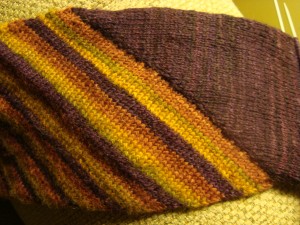
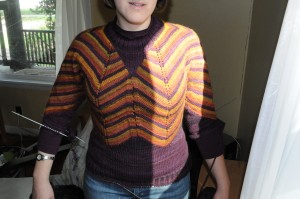
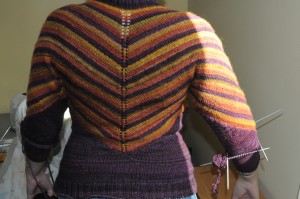
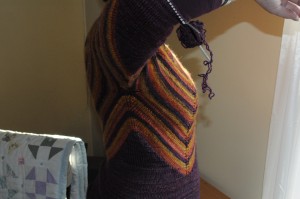
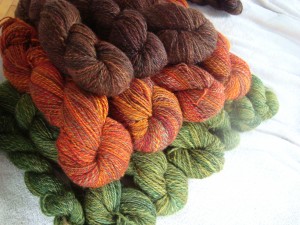
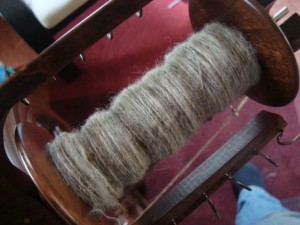
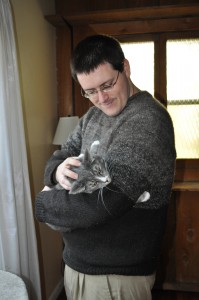
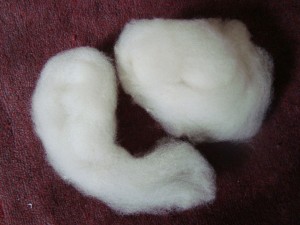
So much wooly goodness here. The sweater truly is taking shape – wonderful shape. I’d like to see it knit in one color with just enough heathering in the yarn to show the lines nicely. I bet it would work just as well as the colorwork.
Of course I love the spinning shots (and think you very generous, indeed, to give up that grey Shetland to a friend).
As for your last line: Heh! – you and me both!
Yay for the home stretch! The sweater’s looking great; I love seeing how the shaping of it works out to make such an interesting design. It will be fun to see the next one take shape, too, I’m sure.
You certainly do! You’d never have to cut the grass!
Happy to see the sweater coming together, I have to admit I was having a hard time picturing it. It’s looking tres chic!
Of course you need a sheep. The sweater is looking all kinds of awesome as well. Yay!
A sheep, huh? Have you talked to Brandon about that? 😉 (I want a goat, so it’s not like I can throw stones here.) The spinning is just gorgeous – I particularly love all the colors for the fall sweater together there! And the sweater is turning out beautifully – I can’t wait to see it all steeked and finished; I bet you will wear that a LOT.
I love the shaping you have done in the sweater and the spinning is lovely!